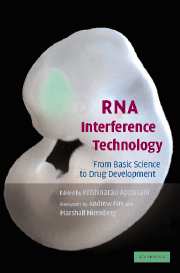Book contents
- Frontmatter
- Contents
- Foreword by Andrew Fire
- Foreword by Marshall Nirenberg
- List of Contributors
- Introduction
- Section one Basic RNAi, siRNA, microRNAs and gene-silencing mechanisms
- Section two Design, synthesis of siRNAs
- 6 Design and synthesis of small interfering RNA (siRNA)
- 7 Automated design and high throughput chemical synthesis of siRNA
- 8 Rational design of siRNAs with the Sfold software
- 9 Enzymatic production of small interfering RNAs
- Section three Vector development and in vivo, in vitro and in ovo delivery methods
- Section four Gene silencing in model organisms
- Section five Drug target validation
- Section six Therapeutic and drug development
- Section seven High-throughput genome-wide RNAi analysis
- Index
- Plate section
- References
7 - Automated design and high throughput chemical synthesis of siRNA
Published online by Cambridge University Press: 31 July 2009
- Frontmatter
- Contents
- Foreword by Andrew Fire
- Foreword by Marshall Nirenberg
- List of Contributors
- Introduction
- Section one Basic RNAi, siRNA, microRNAs and gene-silencing mechanisms
- Section two Design, synthesis of siRNAs
- 6 Design and synthesis of small interfering RNA (siRNA)
- 7 Automated design and high throughput chemical synthesis of siRNA
- 8 Rational design of siRNAs with the Sfold software
- 9 Enzymatic production of small interfering RNAs
- Section three Vector development and in vivo, in vitro and in ovo delivery methods
- Section four Gene silencing in model organisms
- Section five Drug target validation
- Section six Therapeutic and drug development
- Section seven High-throughput genome-wide RNAi analysis
- Index
- Plate section
- References
Summary
Introduction
The application of RNA interference (RNAi) to mammalian cells (Caplen et al., 2001; Elbashir et al., 2001a) has the potential to revolutionize the field of functional genomics and target validation in drug discovery research (Harborth et al., 2001; Tuschl and Borkhardt, 2002). In addition RNAi is also viewed as potential means for nucleic acid-based therapeutic applications. The ability to simply, effectively, and specifically down-regulate the expression of genes in mammalian cells holds enormous scientific, commercial, and therapeutic potential. To ensure success in gene silencing experiments, the design and synthesis of the targeting molecule (the siRNA) must be carefully optimized. The present chapter describes the design criteria for successful gene silencing, followed by a description of recent improvements in high-throughput chemical synthesis of siRNAs, and transcriptome wide gene silencing studies.
Advantages of using RNAi over other technologies for functional genomics
A variety of methods and technologies are available for studying gene function such as gene knockouts and transgenic animal models (Capecchi, 1989; Feil et al., 1996; Jaenisch, 1998; Le and Sauer, 2001; Perkins, 2002), the majority of which are time-consuming and expensive. To facilitate functional genomics in mammalian cells at a transcriptome-wide level, an efficient approach that enables rapid and high throughput analysis is required. Use of synthetic siRNA for RNA interference offers a rapid and cost-effective alternative to previous methods, and can be used to silence expression of several genes simultaneously (Harborth et al., 2001; Kamath et al., 2003; Kamath and Ahringer, 2003).
Information
- Type
- Chapter
- Information
- RNA Interference TechnologyFrom Basic Science to Drug Development, pp. 118 - 128Publisher: Cambridge University PressPrint publication year: 2005
